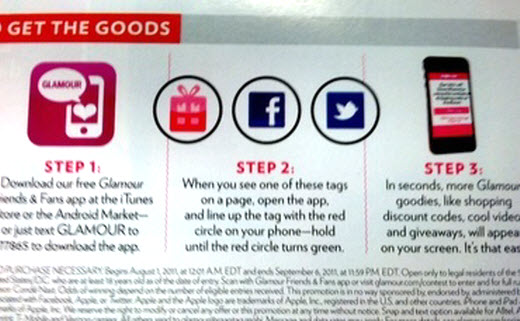
Vikki Chowney, News Editor, Econsultancy.com
In fact, a trial within its 'social edition' from September produced 512,339 engagements among a circulation of 2m readers – just over 25%.
ClickZ reports that Glamour's editorial and marketing departments teamed up to create content that encouraged the download of a 'Friends & Fans mobile app.
A piece of editorial explained to readers that they could ‘like’ advertisers on Facebook via the QR code-enabled logos dotted around the magazine, highlighting that this would lead to exclusive discounts for their products.
Advertisers in turn collected 50,814 Facebook 'likes', a 4% response rate, which included fashion/beauty, retail, CPG, and tech brands. Among them were Gap, Lancome, Skinny Cow and HTC.
Glamour’s creative services director Jenny Bowman said that the magazine was getting so many questions about how [brands] could increase their likes on Facebook, and it wanted to do something "digital and cool". There were elements on Twitter and ways to win prizes as well. In the end, we were able to attract 25 advertisers into that issue that wanted to build likes on Facebook."
The magazine now plans to run print ads in March allowing readers to purchase items with a scan of their smartphone.
Is this a fair example to judge the success of QR codes on? We think it is.
Here, Glamour is using QR codes to provide extra content that is relevant to an already-engaged group of users. This is a smart way to use the technology to direct people elsewhere.
People are now well up to speed on how to download an app, why it could provide them with free 'stuff' - and also how easy it is to remove if you don't use it.
By creating an app that has a QR reader within, this removes that barrier, as well as the need to fiddle about with opening a browser on your handset.
The entire process becomes much simpler, and less intimidating.
Perhaps this is the best way to capitalise on the QR trend, as opposed to using them within outdoor ads that reach a much wider and more random net of people, with relatively few instructions.
As is often the case, the more targeted, the better.
This post was originally published on Econsultancy.com on 10th January 2012. The original article can be accessed here.


No comments:
Post a Comment
We would love to hear your thoughts so make sure you comment on our posts!